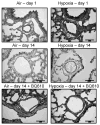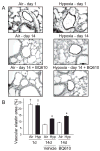Endothelin-1 mediates hypoxia-induced increases in vascular collagen in the newborn mouse lung
- PMID: 17413856
- PMCID: PMC2517238
- DOI: 10.1203/pdr.0b013e318045beae
Endothelin-1 mediates hypoxia-induced increases in vascular collagen in the newborn mouse lung
Abstract
Endothelin-1 (ET-1) mediates hypoxia-mediated pulmonary vascular remodeling (HPVR), and endothelin-A receptor (ET-AR) blockade prevents HPVR in newborn mice. Our objective was to determine postnatal effects of chronic hypoxia and/or ET-AR blockade on lung ET-1, ET-AR, ET-BR, and vascular collagen and elastin. Newborn C57BL/6 mice (n = 6-8/gp) given either BQ610 (ET-AR blocker) or vehicle were exposed to air or hypoxia (12% O2) from birth for 1, 3, or 14 d. Lung ET-1 was assessed by ELISA, and ET-AR and ET-BR by immunohistochemistry. Vascular collagen and elastin were assessed by quantitative image analysis. ET-1, ET-AR, ET-BR, collagen I and III, and tropoelastin mRNA levels were assessed by real-time quantitative RT-PCR. We observed that: 1) hypoxia attenuated the normal postnatal decrease in ET-1 and collagen content; 2) ET-AR blockade reduced collagen independent of O2; 3) hypoxia increased elastin mRNA expression and attenuated the normal postnatal decrease in elastin content; and 4) BQ610 reduced elastin mRNA but not elastin content. We conclude that, in neonatal mice, hypoxia attenuates normal postnatal decreases in ET-1, vascular collagen, and elastin. ET-AR blockade reduces collagen fiber area but not mRNA, and does not decrease elastin despite reducing its expression.
Figures





References
-
- Murphy JD, Vawter GF, Reid LM. Pulmonary vascular disease in fatal meconium aspiration. J Pediatr. 1984;104:758–762. - PubMed
-
- Walsh-Sukys MC. Persistent pulmonary hypertension of the newborn. The black box revisited. Clin Perinatol. 1993;20:127–143. - PubMed
-
- Goodman G, Perkin RM, Anas NG, Sperling DR, Hicks DA, Rowen M. Pulmonary hypertension in infants with bronchopulmonary dysplasia. J Pediatr. 1988;112:67–71. - PubMed
-
- Steinhorn RH, Fineman JR. The pathophysiology of pulmonary hypertension in congenital heart disease. Artif Organs. 1999;23:970–974. - PubMed
-
- Rabinovitch M, Gamble WJ, Miettinen OS, Reid L. Age and sex influence on pulmonary hypertension of chronic hypoxia and on recovery. Am J Physiol. 1981;240:H62–H72. - PubMed
Publication types
MeSH terms
Substances
Grants and funding
- HL-50147/HL/NHLBI NIH HHS/United States
- HL-44195/HL/NHLBI NIH HHS/United States
- K08 HD046513/HD/NICHD NIH HHS/United States
- R01 HL056046/HL/NHLBI NIH HHS/United States
- T32 HL007457/HL/NHLBI NIH HHS/United States
- R01 HL045990/HL/NHLBI NIH HHS/United States
- HL-45990/HL/NHLBI NIH HHS/United States
- R29 HL056046/HL/NHLBI NIH HHS/United States
- HL-07457/HL/NHLBI NIH HHS/United States
- R01 HL044195/HL/NHLBI NIH HHS/United States
- C06 RR 15490/RR/NCRR NIH HHS/United States
- HL-56046/HL/NHLBI NIH HHS/United States
- C06 RR015490/RR/NCRR NIH HHS/United States
LinkOut - more resources
Full Text Sources
Research Materials

